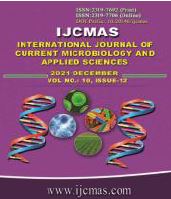


 National Academy of Agricultural Sciences (NAAS)
National Academy of Agricultural Sciences (NAAS)

|
PRINT ISSN : 2319-7692
Online ISSN : 2319-7706 Issues : 12 per year Publisher : Excellent Publishers Email : editorijcmas@gmail.com / submit@ijcmas.com Editor-in-chief: Dr.M.Prakash Index Copernicus ICV 2018: 95.39 NAAS RATING 2020: 5.38 |
In recent years, fungal infections have risen exponentially and are a cause of significant morbidity and mortality especially in high risk babies. Although Candida albicans remains the most common fungal isolate from neonatal candidemia, longitudinal studies have detected a shift towards non-albicans Candida (NAC) species. To study the species distribution and antifungal susceptibility pattern of candidiasis among high risk neonates and infants. Samples were collected aseptically from 128 high risk neonates and infants admitted in the NICU and HDU at JNMCH, Aligarh from February 2013 to October 2014. They were cultured and identified by standard microbiological techniques. Antifungal susceptibility testing (Disc diffusion and broth micro dilution-minimum inhibitory concentration (BMD-MIC) was performed and interpreted as per NCCLS (M27-A2) and CLSI guidelines. Of the 128 neonates and infants studied 89 (69.5 %) had septicaemia, 14(10.9 %) had oral thrush and 12 (9.4 %) had urinary tract infections. In our study we found 39 cases from which 49 isolates of Candida were isolated from different specimen. Of the 39 candidiasis cases Candida albicans (59.2%) was the most common species isolated while non albicans Candida (NAC) were 40.8% (C. tropicalis 14.3%, C. parapsilosis 12.2%, C. guilliermondii 6.2%, C. glabrata 4%, C. krusei 2% and C. dubliniensis 2%). Resistance to fluconazole, ketoconazole, clotrimazole was observed in 10.3%, 10.3%, 6.8% isolates of C. albicans respectively. Resistance to fluconazole, clotrimazole and amphotericin B was observed in 15%, 20%, 16.7% isolates of NAC respectively. No resistance was observed against itraconazole and nystatin. The maximum mortality was found in patients with NAC infections (52.9%) in comparison to C. albicans infection (31.8%). There is a considerable increase in Candida infections especially with NAC in neonates and infants with more resistance towards antifungal drugs.
 |
 |
 |
 |
 |